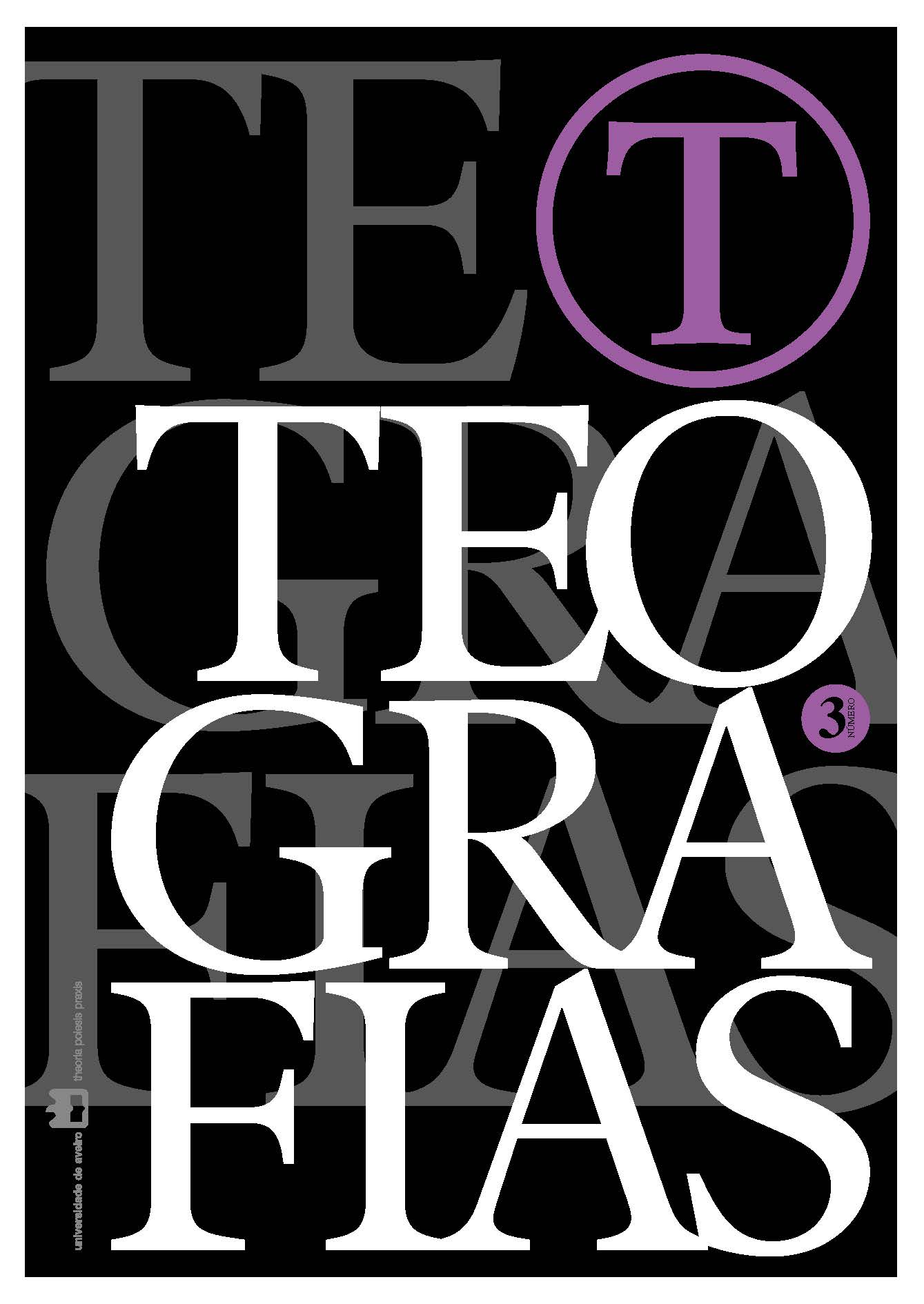Profanando o improfanável: fetos em arte
Resumo
O objectivo deste ensaio é reflectir sobre a cada vez maior exposição mediática do embrião e do feto tanto na cultura científica como no imaginário cultural e popular, assim como sobre as consequências e contestações dessa maior visibilidade, a partir de algumas representações artísticas e literárias. Será dada especial atenção ao trabalho dos artistas Suzanne Anker, Damien Hirst e Marc Quinn, assim como da escritora Sylvia Plath, como ilustrações contemporâneas da aparente autonomia e crescente iconicidade dessacralizada do feto, que inserido num discurso que enfatizava a sua “santidade” é transposto agora para um contexto que sublinha a sua faceta mais profana e secular. Será utilizado especialmente o trabalho teórico da historiadora de ciência Donna Haraway, de Paul Virilio e de Giorgio Agamben, em particular “Elogio da Profanação”, para ajudar a analisar a ética visual das representações em questão.
Referências
AGAMBEN, Giorgio (2007). Profanações. Tradução e apresentação Selvino J. Assmann. São Paulo: Boitempo.
ANKER, Suzanne (2010). “The Glass Veil: Interview: Suzanne Anker and Sabine Flach”. In FLACH, Sabine, MARGULIES, Daniel, SÖFFNER, Jan (eds.). Habitus in Habitat I: Emotion and Motion. Berna: Peter Lang, 141-158.
ANKER, Suzanne (2012). “The Extant Vamp(or the)ire of It All: Fairy Tales and Genetic Engineering”. In SCALA, Mark (ed.). Fairy Tales, Monsters, and the Modern Imagination. Nashville, Tennessee: Vanderbilt University Press, 37-46.
ANKER, Suzanne (2013). “Inside/Out: Fetal Specimens through a 21st Century Lens”. http://www.corporeality.net/museion/suzanne-anker-insideout-fetal-specimens-through-a-21st-century-lens/, 16/7/2013.
ANKER, Suzanne, FRANKLIN, Sarah (2011). “Specimens as Spectacles: Reframing Fetal Remains”. Social Text 29:1, 103-125.
BUCK, Louise (1996). “Unnatural Selection”. In Stilled Lives. Catalogue, Portfolio Gallery, Edimburgo.
BYNUM, Caroline Walker (1992). “The Female Body and Religious Practice in the Later Middle Ages”. In Fragmentation and Redemption: Essays on Gender and the Human Body in Medieval Religion. Nova Iorque: Zone, 181-238.
CHESELDEN, William (1733). Osteographia, or the Anatomy of the Bones. Londres: William Bowyer.
DALÍ, Salvador (1993). The Secret Life of Salvador Dalí. Trad. Haakon M. Chevalier. Nova Iorque: Dover Publications.
DERY, Mark (1999). “Nature Morte: Formaldehyde Photography and the New Grotesque”. In The Pyrotechnic Insanitarium: American Culture on the Brink. Nova Iorque: Grove Press, 145-166.
DIJCK, José van (2005). The Transparent Body: A Cultural Analysis of Medical Imaging. Seattle e Londres: University of Washington Press.
DUDEN, Barbara (1993). Disembodying Women: Perspectives on Pregnancy and the Unborn, Cambridge, Mass.: Harvard University Press.
FERREIRA, Aline (2005). “Fantasies of Intra-Uterine Life and Immaculate Conceptions: Breton, Dalí and Ernst”. In PEREIRA, Frederico (ed.). Literature and Psychoanalysis. Edições ISPA: Lisboa, 133-147.
FRANKLIN, Sarah (1999). “Dead Embryos: Feminism in Suspension”. In MORGAN, Lynn, MICHAELS, Meredith (eds.). Fetal Subjects, Feminist Positions. Filadélfia, PN: University of Pennsylvania Press, 61-82.
FREUD, Sigmund (1985). “The Uncanny”. In DICKSON, Albert (ed.). Art and Literature (The Pelican Freud Library, vol. 14). Harmondsworth: Penguin Books.
HANSEN, Julie V. (1996). “Resurrecting Death: Anatomical Art in the Cabinet of Dr. Frederik Ruysch”. Art Bulletin 78:4, 663-679.
HARAWAY, Donna (1997). Modest-Witness@Second_Millennium. FemaleManÓ_Meets_OncomouseTM: Feminism and Technoscience. Nova Iorque e Londres: Routledge.
HIRST, Damien (2012). “Nicholas Serota interviews Damien Hirst, 14 July 2011”. In Damien Hirst. London: Tate Publishing, 91-99.
INGHAM, Karen (2008). “The Anatomy Lesson of Professor Moxham”. In BLEEKER, Maaike (ed.). Anatomy Live: Performance and the Operating Theatre. Amesterdão: Amsterdam University Press, 75-92.
JUNG, Jacqueline (2007). “Crystalline Wombs and Pregnant Hearts: The Exuberant Bodies of the Katharinenthal Visitation Group”. In FULTON, Rachel, HOLSINGER, Bruce W. (eds.). History in the Comic Mode: Medieval Communities and the Matter of Person, Nova Iorque: Columbia University Press, 223-237.
KINGSLEY, Charles (1957 [1863]). Water Babies: A Fairy Tale for a Land Bab. Londres: J. M. Dent & Sons.
KRISTEVA, Julia (1987). “Stabat Mater”. In Tales of Love. Trad. Leon S. Roudiez. Nova Iorque: Columbia University Press.
MOFFITT, John F. (2008). Painterly Perspective and Piety: Religious Uses of the Vanishing Point, from the 15th to the 18th Century. Jefferson, NC: McFarland.
MORGAN, Lynn M (2009). Icons of Life: A Cultural History of Human Embryos. Berkeley, CA: University of California Press.
NILSSON, Lennart (1965). “The Drama of Life Before Birth”. Life Magazine, 30 de Abril de 1965.
O’RIORDAN, Kate (2010). The Genome Incorporated: Constructing Biodigital Identity. Farnham: Ashgate Publishing.
PETCHESKY, Rosalind (1987). “Fetal Images: The Power of Visual Culture in the Politics of Reproduction”. Feminist Studies 13:2, 263-292.
PLATH, Sylvia (1965). “Medusa”. In Ariel. Londres: Faber and Faber. (1981). “Two views of a cadaver room”. In Collected Poems. Ed. Ted Hughes. Nova Iorque: Harper. (2005). The Bell Jar. Nova Iorque: HarperCollins. (2008). “Johnny Panic and the Bible of Dreams”. In Johnny Panic and the Bible of Dreams: Short Stories, Prose, and Diary Excerpts. Nova Iorque: HarperCollins.
PORTH, Emily F. (2012). “When Women Birthed Mooncalves and Moles: The Display of Fetal Remains and the Invisibility of Females in Museums”. Humanimalia 4:1. http://www.depauw.edu/humanimalia/issue%2007/porth.html, 15/7/2013.
RAYMOND, Claire (2006). The Posthumous Voice in Women’s Writing from Mary Shelley to Sylvia Plath. Farnham: Ashgate Publishing.
SHAW, Debra Benita (2009). “Technology, Death and the Cultural Imagination”. Science as Culture 18: 3, 251-260.
SINGER, Peter (2005). “The Sanctity of Life”. Foreign Policy, Sept/Oct 2005. http://www.utilitarianism.net/singer/by/200509--.htm, 20/7/2013.
SLADEN, Mark (2004). “A Red Mirror”. In SLADEN, Mark (ed.). Helen Chadwick. Londres: Barbican Art Gallery e Hatje Cantz Publishers, 13-32.
SQUIERS, Carol (2013). “How Human: Life in the Post-Genome Era?”. http://museum.icp.org/museum/exhibitions/how_human/how_human.pdf, 27/5/2013.
VERHEYEN, Egon (1964). “An Iconographic Note on Altdorfer’s Visitation in the Cleveland Museum of Art”. The Art Bulletin 46: 4, 536-539.
VIRILIO, Paul (2006 [2000]). Art and Fear. Trad. Julie Rose. Londres: Continuum. Título original: La Procédure silence, Éditions Galilée.
WHITMAN, Walt (1900). “A Hand Mirror”. In Leaves of Grass. Filadélfia: David McKay.





